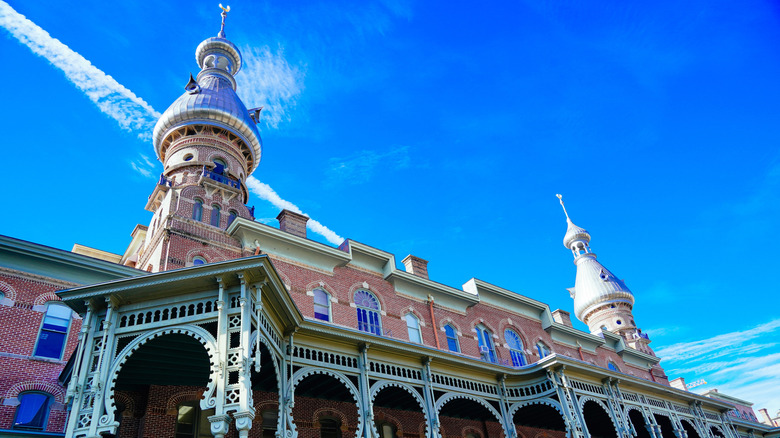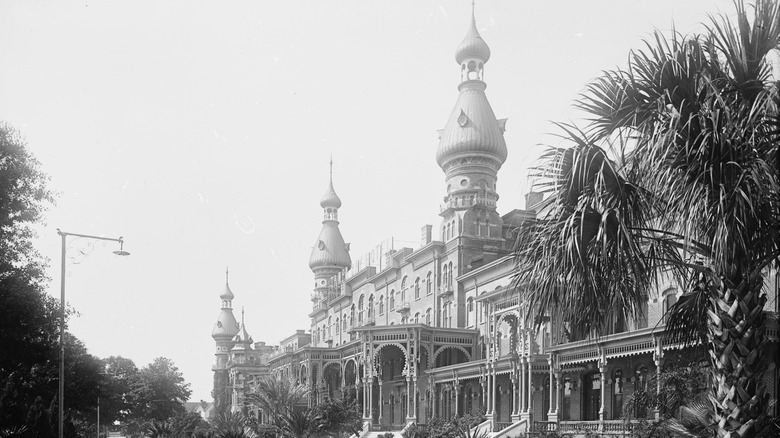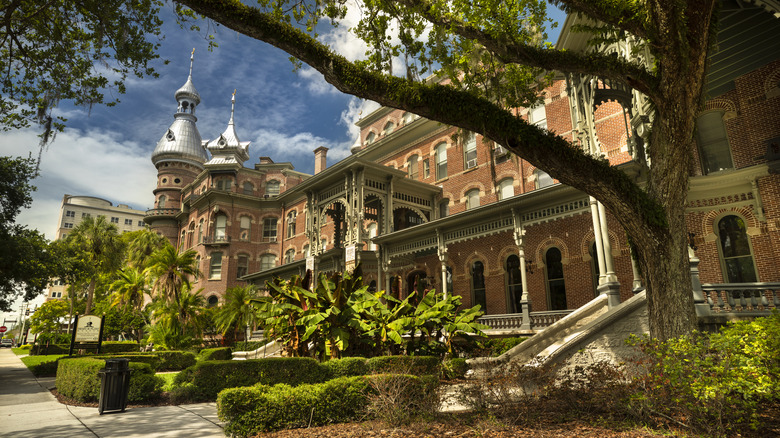
Glittering on Florida's Gulf Coast, Tampa is one of the Sunshine State's most vibrant destinations. Famous for cigars, Cuban sandwiches, and secret sandy party beaches, the illustrious city is also rich with history. Although the area was discovered by a Spanish explorer in 1513, it wasn't until the late 19th century that Tampa began evolving into the thriving city it is today. An industrial boom, ushered in by a railroad extension running through the area, brought wealth and tourism to Tampa. A series
of luxurious hotels were built along the rail line to accommodate the growth.
The Tampa Bay Hotel, constructed by Henry B. Plant — the founder of Plant System railroads and steamships — was one such lavish retreat. Although it no longer operates as a hotel, the historic landmark now houses the Henry B. Plant Museum, connecting Tampa's opulent past to the 21st century. If you're planning a Florida vacation in Tampa, and are looking to sprinkle your journey with some historic gems, you'll definitely want to include the former Tampa Bay Hotel on your itinerary.
Read more: The Most Charming Cobblestone Streets In America That Will Take You Back In Time
The History Of The Tampa Bay Hotel

Constructed between 1888 and 1891, the Moorish Revival-style hotel cost $2 million to build and another $500,000 to furnish. Henry B. Plant built the Tampa Bay Hotel, along with a chain of luxurious resorts peppered along the rail line, to lure tourists to Tampa during the Spanish-American war. The hotel stood as a symbol of grandeur.
Situated on 150 acres, its expansive grounds featured golf, tennis, and shuffleboard courts, a race track, a conservatory filled with exotic plants and flowers, as well as areas for hunting, boating, and fishing. Added in 1896, the Tampa Bay Casino brought an array of entertainment options to the property, including a 2,000-seat opera house, an indoor heated swimming pool, bowling alley, and spa accommodations. The amenity-packed oasis offered more than a place to sleep — it was a playground of lavish delights.
The hotel itself boasted five stories and fearured 511 exquisite rooms — among the first in Florida to be equipped with electricity. Inside, guests could shoot pool in the billiard room, relax in the Grand Salon or piano-adorned Music Room, and dine like royalty in the formal dining room. Outfitted with elegant European furnishings, including ornate Venetian mirrors and baroque furniture, the hotel attracted an all-star cast of guests. Over the years, luminaries like Babe Ruth, Anna Pavlova, and former President Grover Cleveland all wandered the hotel's opulent halls, which thrived until its closure in 1932.
Visiting The Tampa Bay Hotel Today

Though you can no longer book a luxurious stay at the Tampa Bay Hotel, you can take a journey back in time at the Henry B. Plant Museum. Named after the hotel's founder, the history museum is housed in what was once the south wing of the hotel. Located about 8 miles east of Tampa Bay International Airport (TPA) — Florida's renowned airport that is considered the best in the country for travel and food — the century-old structure is one of Tampa's most historic buildings, and a must-visit for history buffs.
For $12, you can take a self-guided tour of its hallowed halls, exploring historical exhibits and admiring original decor and artifacts from the hotel's heyday. On permanent display is a collection of 19th-century furniture, statues, paintings, and ceramic vases. Meanwhile, the museum's rotating exhibits cover everything from 1890s fashion to the Spanish-American war of 1898. On select dates, the museum also offers live theater performances in which actors portray real-life staff members and guests from the Tampa Bay Hotel. The performances are included in the admission price, offering an immersive glimpse into the building's Gilded Age past.
Ready to discover more hidden gems and expert travel tips? Subscribe to our free newsletter for access to the world's best-kept travel secrets.
Read the original article on Islands.













